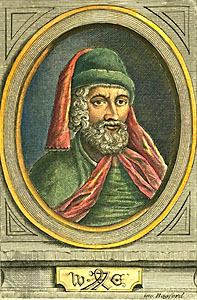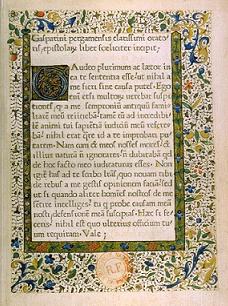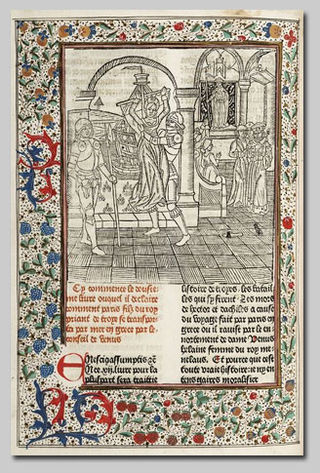Events
| Medieval and Renaissance literature |
|---|
| Early medieval |
| Medieval |
By century |
| European Renaissance |

- 1403 – A guild of stationers is founded in the City of London. As the Worshipful Company of Stationers and Newspaper Makers (the "Stationers' Company"), it continues to be a Livery Company in the 21st century.
- 1403–08 – The Yongle Encyclopedia is written in China.
- c. 1408–11 – An Leabhar Breac is probably compiled by Murchadh Ó Cuindlis at Duniry in Ireland.
- c. 1410 – John, Duke of Berry, commissions the Très Riches Heures du Duc de Berry , illustrated by the Limbourg brothers between c. 1412 and 1416.
- 1424 – The first French royal library is transferred by the English regent of France, John of Lancaster, 1st Duke of Bedford, to England.
- 1425 – At about this date the first Guildhall Library (probably for theology) is established in the City of London under the will of Richard Whittington. [1]
- 1434 – Japanese Noh actor and playwright Zeami Motokiyo is exiled to Sado Island by the Shōgun.
- 1438: 28 April – Completion of Margery Kempe's The Book of Margery Kempe , the first known English autobiography, begins (by dictation) [2] at Bishop's Lynn in England; it will not be published in full until 1940.
- 1442 – Enea Piccolomini, the future Pope Pius II, arrives at the court of Frederick III, Holy Roman Emperor, in Vienna, who names him imperial poet.
- 1443 – King Sejong the Great establishes Hangul as the native alphabet of Korean. It is first described in the Hunminjeongeum published on 9 October 1446
- 1444: 15 June – Cosimo de' Medici founds a public library at San Marco, Florence, based on the collection of Niccolò de' Niccoli. [3]
- 1448 – Pope Nicholas V founds the Vatican Library in Rome.
- 1450 – Johannes Gutenberg has set up his movable type printing press as a commercial operation in Mainz by this date and a German poem has been printed. [4]
- 1451
- 1 August – A manuscript of Dante's Divine Comedy is sold in London. [5]
- Sir Thomas Malory of Newbold Revel in Warwickshire, England, presumed author of the chivalric tales of Le Morte d'Arthur , is imprisoned for most of the following decade on multiple charges including violent robbery and rape.
- 1452 – Completion of the Malatestiana Library (Biblioteca Malatestiana) in Cesena (in the Emilia-Romagna region of Italy, commissioned by the city's ruler Malatesta Novello), the first European public library, in the sense of belonging to the commune and open to all citizens. [6]
- 1452–3 – Johannes Gutenberg in Mainz probably prints the Sibyllenbuch , a poem of about 74 pages, of which only a fragment survives, making it the earliest known remnant of any European book printed using movable type. [7]
- 1453 – Pageant of Coriolan staged in the piazza of Milan Cathedral.
- 1455
- 23 February – Johannes Gutenberg completes printing of the Gutenberg Bible in Mainz, the first major book printed with movable type in the West, using a textualis blackletter typeface.
- 5 June – French poet François Villon is implicated in a murder.
- 1457
- 14 August – The Mainz Psalter, the second major book printed with movable type in the West, the first to be wholly finished mechanically (including colour) and the first to carry a printed date, is printed by Johann Fust and Peter Schoeffer for the Elector of Mainz.
- The Central Library of Astan Quds Razavi in Persia is known to be in existence.
- 1460 – From about this date, Matthias Corvinus, King of Hungary, begins to form the Bibliotheca Corviniana, Europe's largest secular library. [8]
- 1461 – Albrecht Pfister is pioneering movable type book printing in German and the addition of woodcut illustrations in Bamberg, producing a collection of Ulrich Boner's fables, Der Edelstein, the first book printed with illustrations. Soon after this he prints the first known Biblia pauperum (picture Bible).

- 1462: 10 September – Robert Henryson enrols as a teacher in the recently founded University of Glasgow in Scotland. [9]
- 1462: 8 November – First known sentence written in Albanian, a Formula e pagëzimit (baptismal formula) by Archbishop Pal Engjëlli.
- 1463: 5 January – François Villon is reprieved from hanging in Paris but never heard of again.
- 1465 – Having established the Subiaco Press at Subiaco in the Papal States in 1464, German printers Arnold Pannartz and Konrad Sweynheim produce an edition of Donatus (lost), a Cicero, De Oratore (September 1465) and Lactantius' De divinis institutionibus (October 1465), followed by Augustine's De civitate Dei in 1467, the first books to be printed in Italy, using a form of Roman type. [10]
- 1467 – German printers Arnold Pannartz and Konrad Sweynheim move from Subiaco to Rome where the Massimo family place a house at their disposal and they publish an edition of Cicero's letters that gives its name to the typographic unit of measurement the cicero. [11]
- 1468
- 31 May – The Byzantine scholar Cardinal Basilios Bessarion donates his library to the Republic of Venice, the foundation of the Biblioteca Marciana .
- The printers Johann and Wendelin of Speyer settle in Venice; their first book published here, Cicero's Epistolae ad familiares, appears in 1469. [12]
- 1470
- Johann Heynlin prints the first book in Paris, the Epistolae Gasparini of Gasparinus de Bergamo (d. c. 1431), a guide to writing Latin prose.
- Nicolas Jenson's edition of Eusebius, published in Venice, is the first book to use a roman type based on the principles of typography rather than manuscript.
- Sermo ad populo predicabilis, a sermon printed in Cologne, is the first book to incorporate printed page numbers.
- 1473
- First book printed in Hungary, Chronica Hungarorum, the "Buda Chronicle".
- First known printing in Poland, Almanach cracoviense ad annum 1474 , a wall calendar.
- 1474
- First book printed in Spain, Obres e trobes en lahors de la Verge María, the anthology of a religious poetry contest held this year in Valencia.
- Approximate date – Georgius Purbachius (Georg von Peuerbach)'s Theoricae nouae planetarum is published in Nuremberg, an early example of the application of color printing to an academic text.
- 1475
- February – Pope Sixtus IV appoints the humanist Bartolomeo Platina as Prefect of the newly-re-established Vatican Library (Biblioteca Apostolica Vaticana) in Rome after Platina has presented him with the manuscript of his Lives of the Popes. [13]
- Rashi's commentary on the Torah is the first dated book to be printed in Hebrew, in Reggio di Calabria. [14]
- (or 1473–74?) – Recuyell of the Historyes of Troye is the first book to be printed in English, by William Caxton in Bruges using his own translation made in 1471. [15]
- 1476
- 30 January – Constantine Lascaris's Erotemata ("Questions", also known as Grammatica Graeca) is the first book to be printed entirely in Greek (in Milan).
- William Caxton sets up the first printing press in England, at Westminster. [15] This year he prints improving pamphlets: Stans Puer ad Mensam (John Lydgate's translation of Robert Grosseteste's treatise on table manners, printed together with Salve Regina); The Churl and the Bird and The Horse, the Goose and the Sheep (both by Lydgate); and a parallel text edition of Cato with translation by Benjamin Burgh. [16]
- First performance of one of Terence's plays since antiquity, Andria in Florence.
- 1477
- The first printed edition of Ptolemy's Geography (in Latin translation as Cosmographia) with maps, published in Bologna, is the first printed book with engraved illustrations [17] [18] and also the first with maps by a known artist, the plates having been engraved by Taddeo Crivelli of Ferrara [19] (book wrongly dated 1462).
- 18 November – Caxton prints Earl Rivers' translation of Dictes or Sayengis of the Philosophres , the first full-length book printed in England on a printing press. [20]

- 1478 – In England
- William Caxton publishes the first printed copy of the Canterbury Tales . [2]
- The Ranworth Antiphoner is presented to St Helen's Church, Ranworth.
- 17 December – First book printed in Oxford. [21]
- 1479
- The St Albans Press, the third printing press in England, is set up in the Abbey Gateway, St. Albans.
- Robert Ricart begins writing The Maire of Bristowe is Kalendar in Bristol, England.
- 1480s (approximate date) – Scottish makar Robert Henryson writes The Morall Fabillis of Esope the Phrygian .
- 1482: 25 January – Probable first printing of the Torah (in Hebrew with vowels and marks of cantillation printed), with paraphrases in Aramaic and Rashi's commentary, printed in Bologna. [22]
- 1483: 22 February – First known book printed in Croatian, the Missale Romanum Glagolitice (Misal po zakonu rimskoga dvora), a missal printed in Glagolitic script, edited in Istria and printed in either Venice or in Croatia at Kosinj.
- 1484: 22 June – First known book printed by a woman, Anna Rügerin, an edition of Eike of Repgow's compendium of customary law, the Sachsenspiegel , produced in Augsburg.
- 1485 – The play Elckerlijc wins first prize in the Rederijker contest in Antwerp.
- 1488 – Duke Humfrey's Library at the University of Oxford receives its first books. [23]
- 1490
- Chinese scholar Hua Sui invents bronze-metal movable type printing in China.
- Publication in Valencia of the prose chivalric romance Tirant lo Blanch completed by Martí Joan de Galba from the work of the knight Joanot Martorell (d. c. 1468), written in Valencian and a pioneering example of the novel in modern Europe.
- 1492: 16 January – Antonio de Nebrija publishes Gramática de la lengua castellana , the first grammar text for Castilian Spanish, in Salamanca, which he introduces to the Catholic Monarchs, Isabella I of Castile and Ferdinand II of Aragon, newly restored to power in Andalusia, as "a tool of empire".
- 1494: 17 August – Blaž Baromić completes the first work of his printing press in Senj, Croatia, a glagolithic missal, the second edition of the Missale Romanum.
- 1495: February–March – An edition of Constantine Lascaris's Erotemata in Greek with a parallel Latin translation (Grammatica Graeca) by Johannes Crastonis is the first book to be published by Aldus Manutius, in Venice, using typefaces cut by Francesco Griffo.
- 1495–1498 – Aldus Manutius publishes the Aldine Press edition of Aristotle in Venice.
- 1496: February – Francesco Griffo cuts the first old-style serif (or humanist) typeface (known from the 20th century as Bembo) for the Aldine Press edition of Pietro Bembo's narrative Petri Bembi de Aetna Angelum Chabrielem liber ("De Aetna", a description of a journey to Mount Etna) published in Venice, Aldus Manutius' first printing in the Latin alphabet and a work which includes early adoption of the semicolon (dated 1495 according to the more veneto ).
- 1497
- 7 February (Shrove Tuesday) – Followers of Girolamo Savonarola burn thousands of "immoral" objects, including books, at the Bonfire of the Vanities in Florence, an episode repeatedly revisited in literature.
- Possible date – First performance of the earliest known full-length secular play wholly in English, Fulgens and Lucrece by Henry Medwall, the first English vernacular playwright known by name, perhaps at Lambeth Palace in London.
- 1499: Late – Contents of the library of the Madrasah of Granada are publicly burned.








